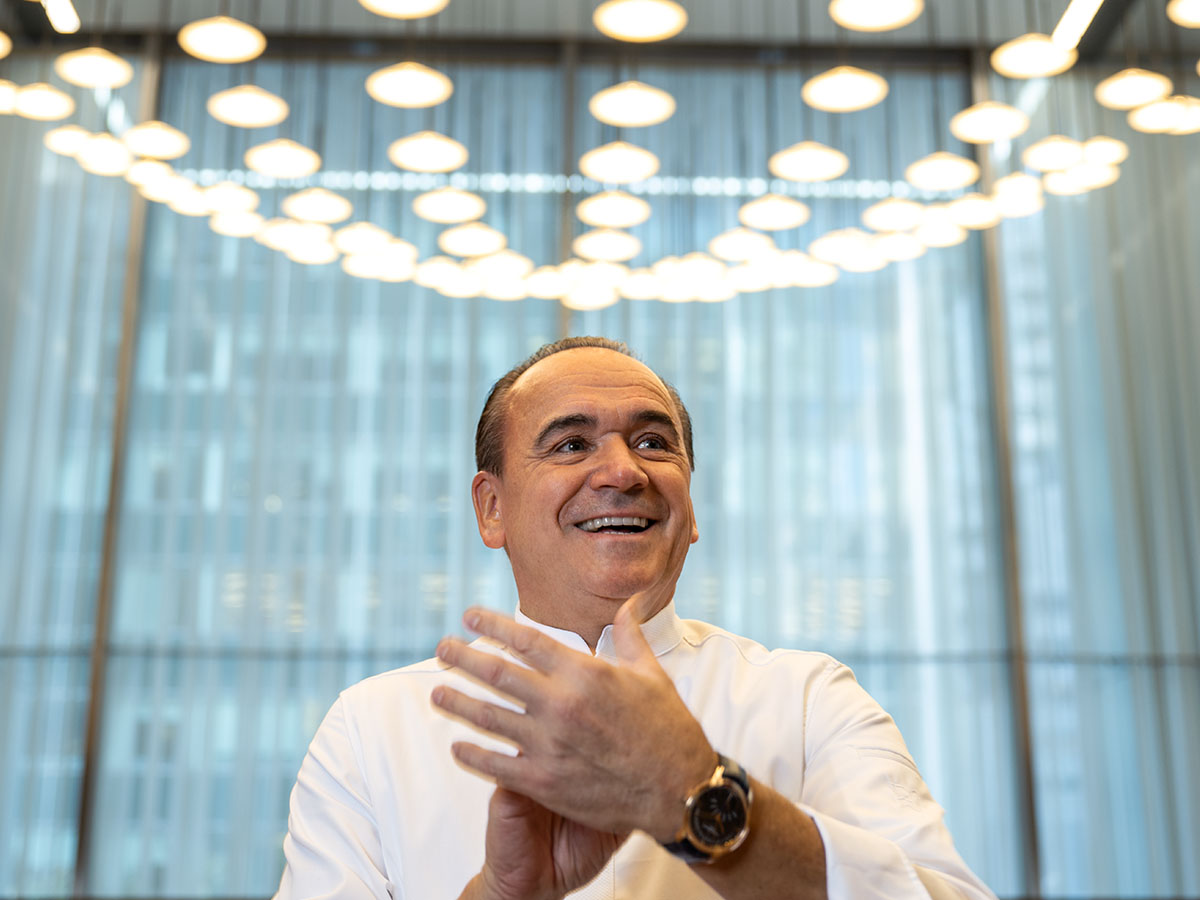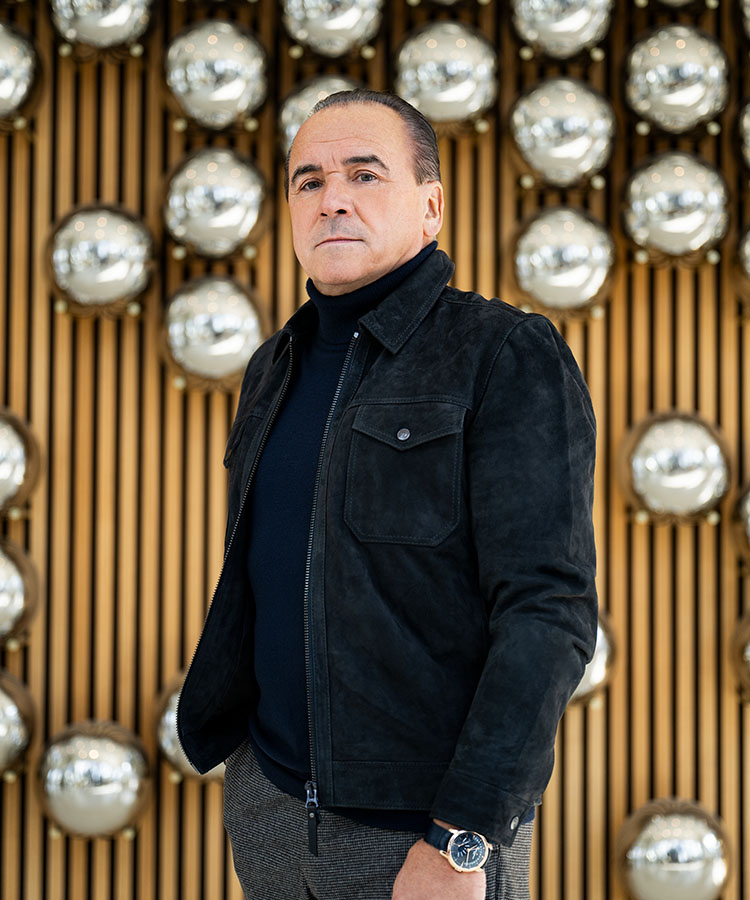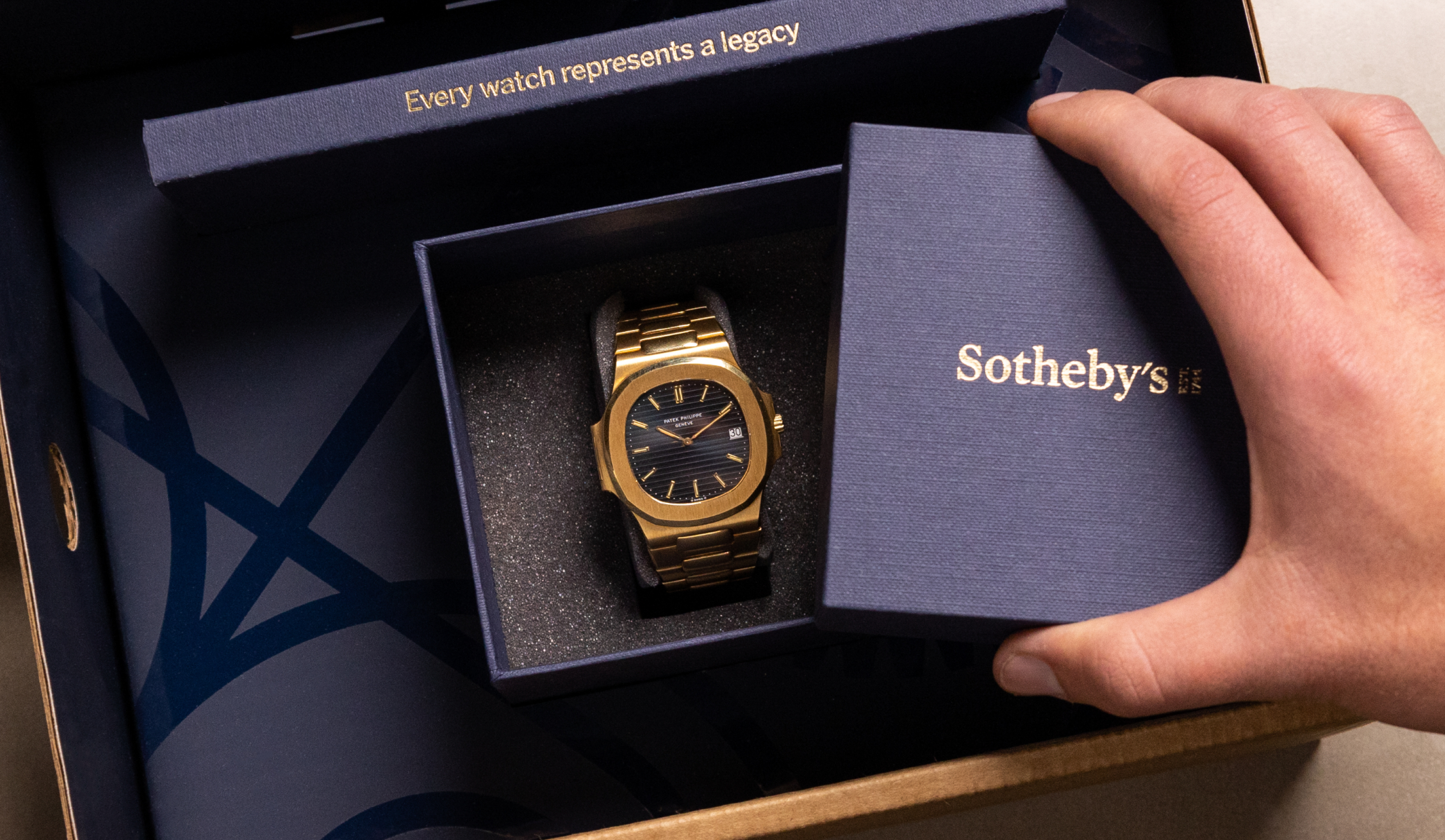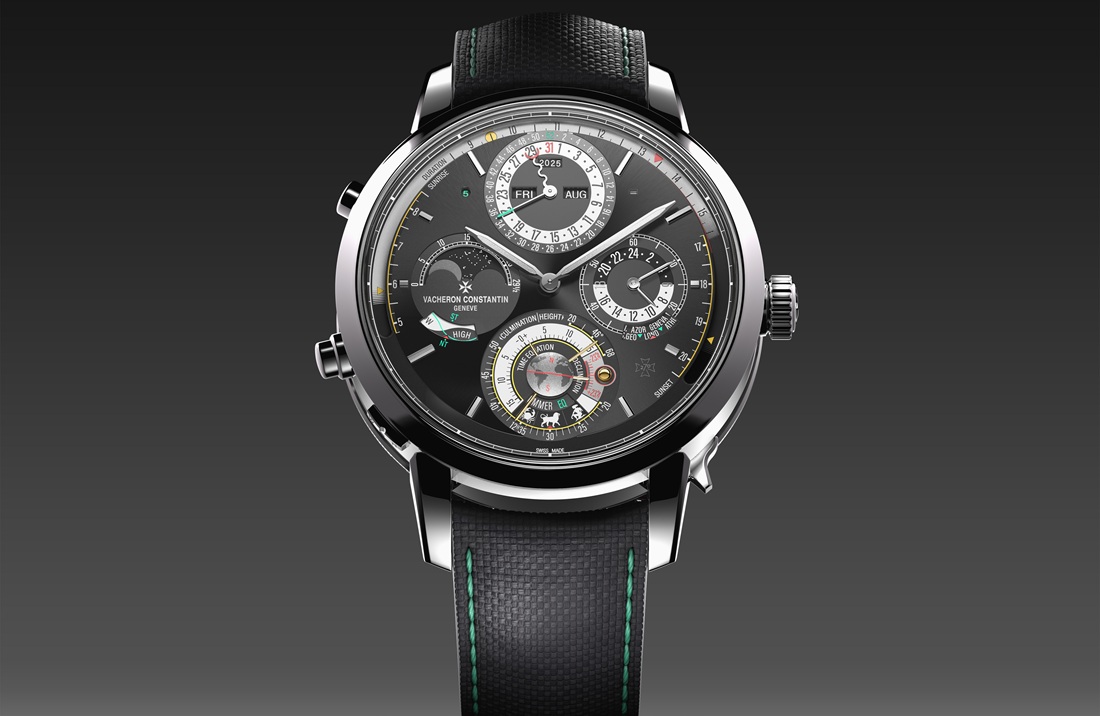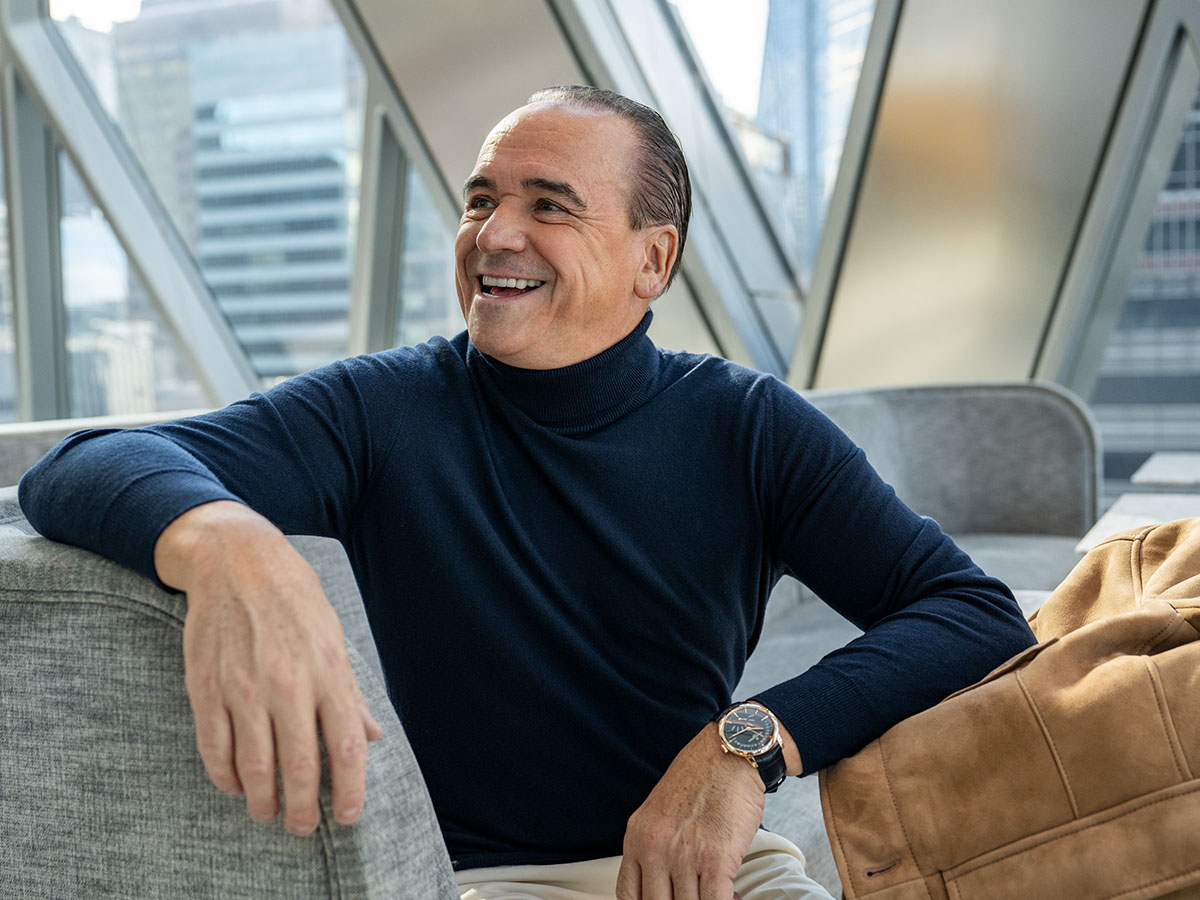
Jean-Georges Vongerichten is Celebrating His 50th Anniversary in the Kitchen in the Biggest Way Possible — Wearing Vacheron Constantin
Jean-Georges Vongerichten is ready to party. And it’s a good thing, too, because regardless of whether he’s ready or not, the 2 Michelin-starred chef is getting ready to celebrate not one, not two, but five milestone moments this year.
BY LAURA SCHREFFLER
PHOTOGRAPHY SCOTT MCDERMOTT
STYLIST ERIN MCSHERRY
GROOMING WALTON NUNEZ
SHOT ON LOCATION AT FOUR TWENTY FIVE, NYC
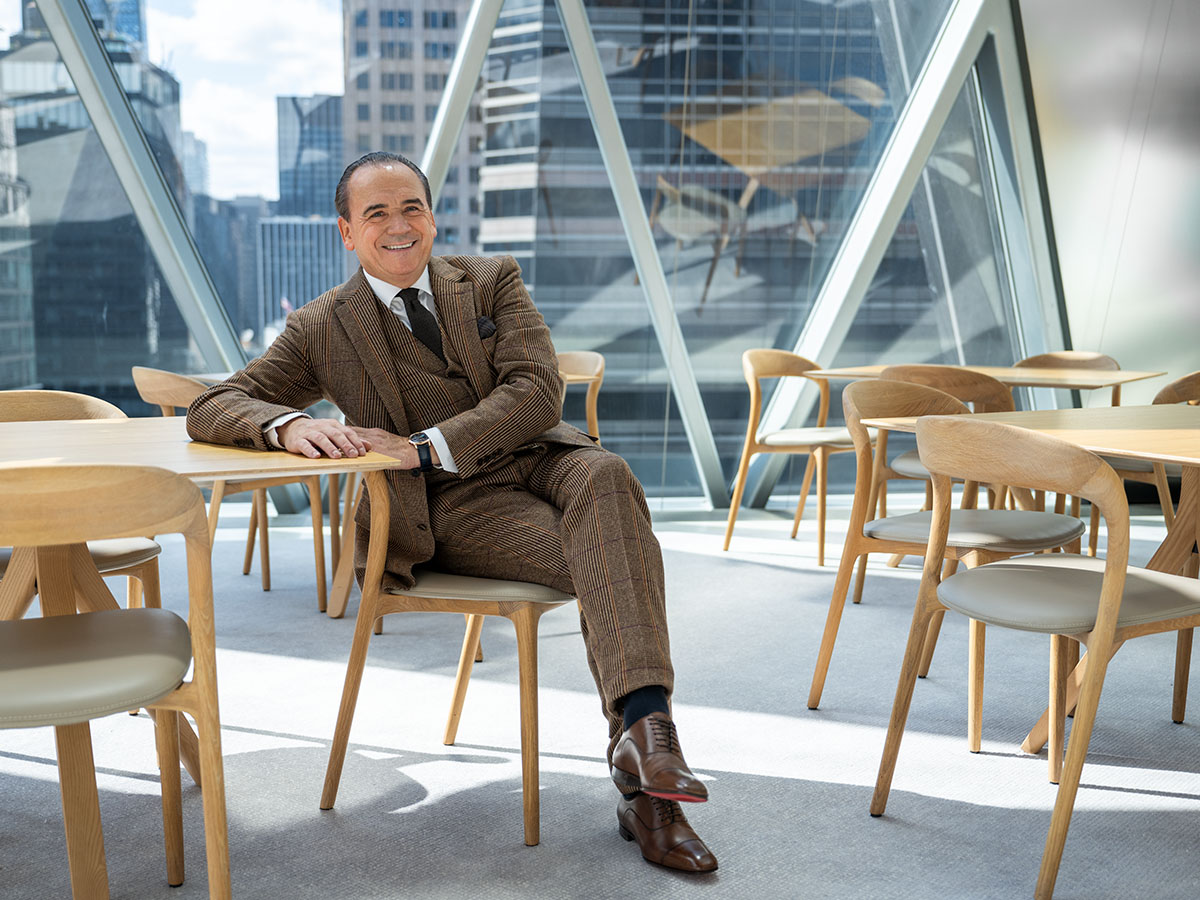
“We have so many anniversaries,” the 66-year-old, French-born chef shares via Zoom just before Labor Day weekend. He lists them off rapid-fire: a 1,000-person extravaganza feting the one-year anniversary of his high-end, South Street Seaport food hall, Tin Building; the 25th anniversary of Las Vegas’ Bellagio Hotel & Casino, where his steakhouse, Prime, is a much beloved fixture; the 100th anniversary of five-star hotel La Mamounia in Marrakech, where he operates both L’Asiatique par Jean-Georges and L’Italien par Jean-Georges; and the 70th anniversary of St. Barths’ Eden Rock hotel, which hosts his Sand Bar restaurant.
“That’s a lot for one year,” I tell him, to which he responds. “That’s one month. In the month of October, there are more things to do than the rest of the year. It will be three weeks in a row of dancing, eating, and drinking.”
It sounds heavenly, but exhausting. When I suggest Liquid I.V. might be a necessary evil, he laughs and reassures me by saying, “I know how to pace myself! Moderation is always my go-to.”
Somehow, I think Vongerichten is going to heed my advice after all, given that I’ve deliberately left out the most significant part of his year: 2023 officially marks his 50th anniversary of cooking (and if that’s not a cause for celebration, I’m not sure what is).
As you’ve heard, he’ll definitely be celebrating with an actual party or five, but he’ll also be commemorating the occasion in a very Jean-Georges kind of way: by opening what will indisputably be one of his most personal restaurants to date this fall.

That restaurant — the 64th in his vast portfolio — is Four Twenty Five, located at the prestigious address of 425 Park Avenue in an L&L Holding Company office tower. It is located across the street from The Drake, where Vongerichten worked when he first arrived in America in 1986, young, hungry, and with only $500 in his pocket, or “poor but rich in skill,” as he sees it.
“I’m very familiar with [the corner where Four Twenty Five is located] because when I first arrived in New York, I lived across the street at The Drake for five years, where they gave me room and board. Much of my view was the building where I’m opening this restaurant.”
As such, when developer David Levinson approached him with the project two-and-a-half years ago (though it had been in the works for the better part of 20 years), he immediately agreed. “I said yes right away. I said incroyable — I am coming full circle!”
And it is as incredible as Vongerichten suggests, having been remarkably designed by esteemed Pritzker Architecture Prize winner Lord Norman Foster of Foster + Partners with what Vongerichten refers to as a “50s-style design. The two-level, 65-seat restaurant” will include a captivating cocktail lounge, bar, and private dining room featuring 45-foot high ceilings, complemented by a stunning staircase and a 24-foot painting created by artist Larry Poons. The hottest seats in the house are located on the Mezzanine level in an intimate dining room suspended above Park Avenue, all of which showcase a spectacular open kitchen where diners can watch Vongerichten and his team — helmed by Jonathan Benno, former Per Se chef and owner of the now-shuttered Lincoln restaurant— in action.
But at the time of our chat, Four Twenty Five is still very much a work in progress. The décor is just being finalized, while the plates, glassware, and kitchen equipment have literally just been purchased. The bones of the place exist, but not much else. Vongerichten and his team have not even set foot in the new space yet, which is just one of the reasons why the menu is still in development (the other being that it’s always the last thing he does when opening any restaurant). He does know this much, though: Four Twenty Five is going to be utterly simple in its concept, if not in its execution. [To note, it will also undoubtedly have excellent mood lighting given that Vongerichten hates bright light: “I’m very sensitive to lighting and, since I was a young kid, have always dimmed the light at night. Some places I go to and I think, How can you even sit on a chair if it feels like daylight at nine o’clock at night? I had a great experience there, but I look terrible. It’s like sitting in a dentist’s chair when the lighting is bad. I don’t feel good about it. I don’t smile as much in too bright of a light,” he shares. But I digress.]
“The menu is coming,” he promises. “The last piece of the puzzle is the food. The building is beautiful but simple, clean-cut, so we want the food to reflect that. [The food will be] market-driven, of course — white fish, beef, duck, lots of vegetables. Pure and simple ingredients, but the best, served in a simple way but with a little touch of spice or herbs; a different technique of cooking. We’ll have organic chicken, but we will season it with licorice or something different and unexpected to make it taste totally different. The idea is really to recreate the dish, to have something very simple, but to extract the best flavor from it.”
Not only does such simplicity need to be handled exquisitely and delicately (though given that this simplicity comes courtesy of Vongerichten, no one’s worried), but each dish also needs to feel fresh — nothing from any of his other 12 New York City restaurants, inclusive of the 2 Michelin-starred Jean-Georges; his first-owned eatery, JoJo; abc kitchen; The Mark; and Nougatine, among others — can be replicated. “We’re not going to be able to repeat one dish from any other restaurant because all eyes are on us, and tastebuds, too, so we’ll have to create something totally unique, totally different here.”
It’s a challenge, to be sure, but he’s well up for it. For Vongerichten, each restaurant is created with care and the utmost attention. They aren’t places he slaps his name on and ignores. He’s still in the trenches with his team daily, working in the kitchen, getting his hands dirty. And he loves it.
“It’s my job to create, but I can’t do it alone. What I love the most is being able to sit down with my chefs and talk about our menus — the next creation, the next restaurant we’re opening, going over plans. It makes me feel more accomplished, being able to wake up in the morning and choose what I’m going to do on any given day. I’m not talking about money when I say that it’s a luxury not to have anyone give me a schedule outside of the one I make for myself. I still run to work after 50 years. I still have the pleasure of waking up and being happy doing what I do. Sure, I have to go to an office and do a couple of hours of business a day, but I still get to be in the kitchen for six or seven hours every day, too. It’s my therapy.”
It’s also his joy. He admits that, on any day that he’s cooking, he’s peeping out at the restaurant from behind the kitchen doors, watching his guests, hopeful that whatever he has created is curating happiness. Like an excited kid on Christmas, he’s eternally hopeful that each diner will enjoy his beautifully presented and carefully prepared present.
“I mean, I enjoy watching people eat,” he admits. “They probably wouldn’t like that. But when I’m in the kitchen, I’m looking to see if people finish what’s on the plate, if they take a piece of bread and wipe the plate. For me, it’s about giving pleasure, and the best compliment is when people leave and make a reservation on the way out.”
But every successful businessman knows that one key element alone isn’t enough to create a winner. “If the food is good, but on top of it, you remember one thing that brings you back to that meal, then you have a business going. It’s about creating cravings, creating ambiance, creating something so unique that you wake up the next morning and say, wow. If it’s not the food, then it’s the flowers, the light, the desserts, the personality of a place — whatever it is, if it makes you come back, that’s when we capture you, that’s when we have you.”
Clearly, the man is on to something.
October might have been his month for nonstop revelry, but that doesn’t mean that Jean-Georges is all play and no work. It’s quite the opposite, in fact. He’s got way too much at stake to slow down now.
In fact, at the time of our chat, he’s about to embark on his “Asian tour,” where he’ll check in on his plethora of restaurants: JG Tokyo; Jean-Georges at The Shinmonzen, a gorgeous little nine-room boutique hotel in Kyoto; Jean-Georges and Mercato in Shanghai; and Mercato in Guangzhou.
Vongerichten has certainly come a long way from his hometown of Alsace, France, and his first day of cooking 50 years ago — the day that would change the course of his life forever. Ironically, that day was Bastille Day — French Independence Day — July 14, 1973. And I say ironically because it was on this day that Vongerichten discovered that cooking could and would bring him both financial and creative freedom.
He had begun a work-study program at Auberge de l’Ill as an apprentice to chef Paul Haeberlin, and that particular day, he got lucky; Haeberlin needed help. “I guess they needed someone to help them prep for the holiday, so they called me up the day before to tell me, ‘You can start tomorrow at eight o’clock.’ And I was there [right on time]. On my first day in the kitchen, I learned how to hold a knife. I was 16 and scared, but happy, too. I mean, I was 16 — that’s an age where you want to leave your home, live your life like a little rebel, and prove yourself, even though it could be a giant mistake if you fall flat on your face.”
Needless to say, he didn’t. “They put me in pastry on my first day, and I did a few things, like make ice cream. It was very smart that they put me, as an apprentice, in pastry because you have to measure everything. At the time, I didn’t know anything about anything, but I knew how to use a scale. That was a big step for me to get going — putting my [chef] whites on, wearing an apron, learning how to sharpen my knives.”
After his initial apprenticeship, he trained under legendary 3 Michelin-starred chefs Paul Bocuse and Master Chef Louis Outhier in Southern France before taking a massive leap of faith and moving to Asia. His first proper job as a chef was at The Oriental Hotel in Bangkok, Thailand (now the Mandarin Oriental Bangkok) in 1980 at age 23. “That was, for me, a culture shock,” he admits. “I had never really left Europe; this was my first time on another continent, and going from a kitchen in France to one in Thailand is a [radically different experience.] The food was a revelation.” But it was here, where he happily worked and traveled, carefree and fresh-faced, that he developed his love for the exotic and aromatic flavors of the East that was to become his signature.
His third and final life-changing moment occurred when he moved to the U.S. in 1985 with “$500 to my name, but some knowledge.” He briefly worked for chef Louis Outhier, opening the Le Marquis de Lafayette restaurant in Boston before deciding to take a bite of the Big Apple. A year later, he arrived in New York to take over the executive chef position at Lafayette in the aforementioned hotel, The Drake, which generated critical acclaim for his innovative interpretation of classical French cuisine and which earned him four stars from The New York Times at the age of 29. It was there that he met financiers and loyal diners Bob Giraldi and Phil Suarez, who assisted him in opening his first restaurant, bistro JoJo, in 1991. After the success of JoJo (and again in partnership with Suarez), Vongerichten then went on to open both Nougatine and his flagship restaurant, Jean-Georges, in 1997. The rest is history.
As such, New York clearly has the longest-reaching impact of any of the cities that have influenced Vongerichten. It is the city he calls home, where he raised his family, and where the majority of his restaurants are located. It is, without a doubt, the city where he has reaped the most rewards.
But obviously, Vongerichten isn’t stopping here, nor anytime soon, either. He currently has a plethora of projects in development, which will likely expand his roster of restaurants to the 70 mark in the near future. He shares, “For the next five years, I really want to go to places that I’ve never been. I wanted to open a restaurant in Dublin, for example. I was approached a month ago to open a place there, and my team said, ‘Are you crazy?’ I said, ‘No! Let’s do it.’ I want to open a beautiful seafood restaurant there. I want to be inspired by Ireland. Bono is a friend, and [one of my partners in Kyoto is Irish, too.] So, for me, opening a restaurant somewhere new — be it Dublin, Kyoto, Paris, London, or Shanghai — is an inspiration. When I visit someplace new, I come back with 50 new ideas. My engine doesn’t stop.”
Clearly not. But I’m more focused on that oh-so-casual Bono reference he tossed in, as if I wouldn’t notice. Hah! “Well, in 50 years, you meet a lot of people!” he protests with a laugh. “Every day, there is a celebrity, another chef, or a regular that comes in. We feed about 5,000 people a day. There is always somebody who you inspire to come back or someone you inspired to be a chef. It’s wonderful.”
But because this is Jean-Georges I’m talking to, eternally humble and always ready to jump in and work alongside his team — two dozen of whom have faithfully worked by his side for the past 25 years — I’m not surprised at his honesty when he says, “We receive so much praise, but we get complaints, too! So you have to take it all in, the good and the bad. But the beautiful part of the restaurant business is that whatever you do, you can fix it. If something doesn’t work for lunch, you can fix it for dinner. If there’s something that doesn’t work for dinner, you can fix it the next day; nothing is really set in stone. You just have to reinvent yourself all the time and raise the bar.”
This is unequivocally part of the legacy he’d like to leave behind, but there are other things, too.
“I [want to be known for creating] not just restaurants, but food memories, too. I also want to be known for curating talent. [Many of the chefs I trained are my] peers now; some are superstars. I try to be a great leader and have a great team because you can do nothing by yourself. My team has been with me for a very long time. [For example], the first chef I hired in the United States was in Boston in 1984. [Executive chef] Pierre Schutz is still my chef at The Mark Hotel. So, the only way I think you can build a little company, a little empire, is to have the right talent. Not everybody wants to open his own restaurant, so we promote them as a chef, executive chef, corporate, or whatever they want to do.”
Additionally, he’s proud of Food Dreams, the nonprofit he created with the Culinary Institute of America run by his daughter, Louise, that provides education for people who can’t afford to go to culinary school from all over the globe, including countries such as Pakistan, India, and the Philippines. Through Food Dreams, select students are mentored by the Jean-Georges team, have the chance to extern at one of Vongerichten’s properties, and receive needed scholarships. “I try to help the world to be a better place my way, creating dishes that people remember,” he says.
And because he’s just shared how he and his cuisine have helped the world, I want to hear specifically what lessons he’s learned in the last 50 years. His answer comes so quickly that it is undoubtedly something he’s thought about many times: how this long, wild ride shaped the person he has become. He says, “It’s taught me to be myself, to be honest. If your fish is rotten, you cannot hide it because it’s going to smell. You have to be transparent. When I was younger, I tried to put up to 50 ingredients on a plate to impress, but as I matured, I learned not to put more than three ingredients on one plate. I learned to take all the superfluous away and go to what is only essential. That’s why, with [Four Twenty Five], I’m going back to the simplicity of life. Food is humbling, and to do a great business is even more humbling.”
In my opinion, the number one reason Jean-Georges Vongerichten is so successful is this: he’s never stopped finding joy in his day-to-day life. Work has never become a job; it has always remained a passion. And what could be more important than finding your passion, your purpose?
On that front, he has serious thoughts. “The most important thing is to have fun. I would have stopped a long time ago if I wasn’t having a good time,” he admits. Then, with a shake of his head, he adds, “[I can’t believe that I started my career] 50 years ago. It went by too fast… and really, I’m just warming up.”
 SIGN UP
SIGN UP

